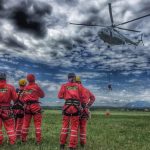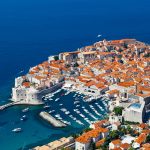June 19, 2019 – TCN meets Croatia’s leading independent defence analyst, Igor Tabak, in a wide-ranging interview of Croatian defence-related issues.
1. The biggest defence story in recent times has been the ill-fated attempt to buy F-16 fighters from Croatia. Lots has been written about why the deal failed. What is your assessment, and should the Croatian government have seen the collapse of the deal coming?
In my experience, when something looks almost too good to be true, it usually is. A serious warning sign should also have been the fact that such a deal has never been conducted before, so Croatia was expected to be the icebreaker for Israel in this respect. If the deal was so good, probably there were reasons that they never came to fruition before. So, all that were valid reasons for special care and restraint in the deals PR or advertising. For a number of months, the official line was that the purchase is almost done, so the shock of its failure got even bigger. As expectations were high, and expected gains (not just a renewal of the Air Force, but related industrial cooperation also) were large, so was the disappointment. If nothing else, those expectations had to have been managed better…
2. As part of its NATO commitments, each member state is required to contribute 2% of GDP. Where is Croatia on this, and what strains has this commitment put on the State budget?
Well, this is a contentious topic of lately. For a number of years the Croatian defence budget was falling, money for the military was really scarce – and that reflected at modernization efforts and overall performance. NATO requires member-states to invest at least 2 % of their GDP in their national defence systems – so, it is not a contribution to NATO, to Bruxelles, but investment at home. Croatia committed to raise its defence spending accordingly in 2014, but had problems adhering to that commitment. After the economic crisis, from 2017 onwards, Croatia spent more on its defence, and managed to achieve 1,31 % of GDP in 2018. This was still far from 2% and it seemed that a lot of work was remaining, in order to invest smartly, raising the Croatian military capabilities in an optimal manner (getting the biggest bang for the buck).
3. As I understand things, the pensions of war veterans are taken into consideration with this contribution. Croatia is in a very different situation regarding veterans, due to the Homeland War. How does this impact the numbers?
Lately, throughout the last year or so, an administrative gimmick was employed there, and all the veteran pensions and benefits (from the Homeland war era) got included into the NATO count – pushing the required percent from 1,31 to 1,71 instantly. On one hand, that seemed as a convenient way to reduce the spending pressures from the US Trump administration. But, as Croatia is one of just two NATO members that had war on its national territory lately (and the only member with a longer and more comprehensive war experience) – Croatia was also the only NATO member to have a population of recent veterans, numerous enough to make a real difference if their pensions and benefits were counted in the NATO statistics. But, as beneficial as that quota might have been in the overall count (“the 2 % goal”), so was this amount of money also detrimental in certain aspects, if added. Its inclusion in the defence expenditure of Croatia (as part of the personnel quota) raised that parameter sky-high – making unachievable the goal of keeping the personnel cost around 50 percent of the overall defence spending.
Also, with this addition to usual personnel quota (and the overall defence spending count), it became much harder to achieve the NATO modernization quota – requirement to invest at least 20 % of member-states annual defence spending into modernization of national defence forces. By this subsidiary criteria, Croatia ended at the bottom of the NATO lists after the veteran spending was included in the overall defence count. That fact is going to be a serious problem in the future.
4. What would be your assessment of the Croatian army as a fighting force today?
The Croatian Armed Forces in total are small, but active. International engagements with NATO, UN and EU give it opportunity to work with major military and political powers, on many of the toughest crisis points around the world. That was ample ground to expand the existing war-time experiences, so even as Croatia has more than 20 years of such engagements, no casualties were inflicted on the members of the Croatian Armed Forces. That is a fact we can be proud of. Still the various national defence capabilities yearn for more modern equipment, as the average age of major weapon systems tends to be several decades.
5. There is periodic talk of the return of compulsory military service in Croatia. Do you think it is possible or likely? Why/why not?
Croatia turned to wholly professional armed forces in 2008. That was done out of financial reasons, but also in order to be able to strengthen the discipline and the professional proficiency of its soldiers in the surroundings that get ever more complicated. Keeping up with developments in defence technology and practice turned to be a real challenge, an a lot of work. All that would be hard if not impossible to do with conscripts, eager to turn their back to the compulsory military service as soon as possible. That is why I don’t see the reintroduction of the compulsory military service as a realistic option for Croatia. Although this idea tends to be popular in certain societal and political circles of Croatia, I found out that it remains on the level of general notions only, with less or no understanding of the overall requirements or costs for such a move. As this change wouldn’t be neither easy, nor cheap – I don’t expect to see it in Croatia any time soon.
6. There are reports of possible ISIS activity and training camps over the border in Bosnia and Hercegovina. What is your view on that and how much of a threat do you consider it to be?
The Islamist fundamentalism has been present in this region for decades now. It is one of more unfortunate legacies of the early 1990s, that took firm root in Bosnia and Herzegovina. Occasional acts of violence against state actors and different ethnic/religious groups happened on a regular basis there, providing work for local and international security actors. So, it is a subject under permanent and close scrutiny. Several hundred people joined ISIS from B&H, while some even died in their ranks throughout recent years. Now, with the Islamic Caliphate destroyed, and with ISIS returning to its roots as a clandestine terrorist organization, the biggest problem for this region pose the fighters trying to return. As deradicalization efforts remain hard to do right – this phenomenon will remain a challenge for all the nations of this region, more or less in scale, but present nevertheless.
7. The biggest threat to regional instability?
I would say that the biggest security threat in the region is posed by the weak governmental systems of individual states. A lack of breath to finish the reform efforts, an inability to establish truly democratic societies, as well as the ever-present corruption, make it hard to form stable governments that serve well the interests of its citizens. That weakness gets worsened by intense emigration of local people, and gets more visible in challenging times (like with the immigration wave that recently passed through the region underway to Germany and the western parts of the EU). Unfortunately, that is not an easy thing to change, nor can it be dealt with fast…
8. People are sometimes to hear that Croatia has a very successful arms export business. Can you tell us a little about it, and where the main export markets are?
In the overall picture of Croatian industry exports that is not rosy, the defence industry turned into a public notion of success. Still, one must note that Croatia has a very small defence industry, that is based around just a few export-oriented companies. The range of products is concentrated around an individual soldier and his infantry equipment – so, primarily around his battledress, boots, modern personal protection, small arms and personal communication equipment. There are efforts to revive the defence related branches of the Croatian shipbuilding and vehicular industry, but those have proven to be much harder to succeed, even with state support (that has proven to be unsteady and at times erratic). So, Croatia currently has a defence industry that is small, dynamic, and export-related. Its markets are all over the world, mostly USA for small arms, or Europe and the Middle East for personal protection equipment. The main challenge remains to help it grow and develop new products that future markets will appreciate.
You can follow the latest from Igor Tabak on regional military and defence issues on his Defence and Security website, OBRIS – Obrana i Sigurnost.









